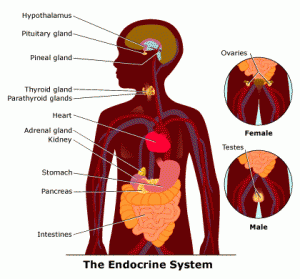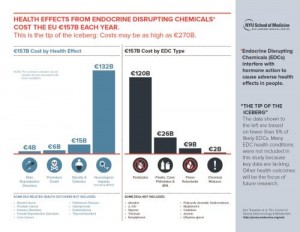13
Mar
Exposure to Hormone Disrupting Chemicals Costs Billions in Lost Brain Power
(Beyond Pesticides, March 13, 2015) Exposure to endocrine (hormone) disrupting chemicals (EDC) results in approximately € 150 billion ($162 billion) in health care costs in the European Union each year, according to panels of scientists tasked by the EU Commission to study their impact. “The shocking thing is that the major component of that cost is related to the loss of brain function in the next generation,” Philippe Grandjean, M.D. of Harvard University, one of the report’s authors, told the Guardian.
 EDCs, contained in common household products such as detergents, disinfectants, furniture, plastics, and pesticides, interfere with the body’s hormone system either by mimicking naturally produced hormones, blocking hormone receptors in cells, or effecting the transport, synthesis, metabolism or excretion of hormones. These impacts can result in devastating effects on one’s health, including behavioral and learning disorders, such as Attention Deficit Hyperactivity Disorder (ADHD), birth defects, obesity, early puberty, infertility, cardiovascular disease, and childhood and adult cancers. Nearly 100 percent of people have detectable amounts of EDCs in their bodies, according to the introductory guide to EDCs published by the Endocrine Society and IPEN.
EDCs, contained in common household products such as detergents, disinfectants, furniture, plastics, and pesticides, interfere with the body’s hormone system either by mimicking naturally produced hormones, blocking hormone receptors in cells, or effecting the transport, synthesis, metabolism or excretion of hormones. These impacts can result in devastating effects on one’s health, including behavioral and learning disorders, such as Attention Deficit Hyperactivity Disorder (ADHD), birth defects, obesity, early puberty, infertility, cardiovascular disease, and childhood and adult cancers. Nearly 100 percent of people have detectable amounts of EDCs in their bodies, according to the introductory guide to EDCs published by the Endocrine Society and IPEN.
“Our brains need particular hormones to develop normally —the thyroid hormone and sex hormones like testosterone and oestrogen. They’re very important in pregnancy and a child can very well be mentally retarded because of a lack of iodine and the thyroid hormone caused by chemical exposure,” Dr. Grandjean explained to the Guardian.
Scientists analyzed the economic impact of a number of EDCs, including phthalates, bisphenol A (BPA), polychlorinated biphenyls (PCBs), dioxins, perfluoroalkyl compounds, as well as DDE and organophosphate and organochlorine pesticides. The work, Estimating Burden and Disease Costs of Exposure to Endocrine-Disrupting Chemicals in the European Union, was published in the Journal of Clinical Endocrinology and Metabolism.
In the analysis, the economic burden of EDCs was calculated based on a 1981 Institute of Medicine approach to assessing the contribution of environment factors in causing illness. Uncertainty in the analysis was addressed by using a weight-of-evidence characterization for probability of causation developed by the Intergovernmental Panel on Climate Change (IPCC), and an epidemiology model used by the World Health Organization.
In addressing whether complete certainty of causation is a necessary basis for analysis, the study makes note of a quote from Sir Austin Bradford Hill, a 20th century epidemiologist renowned for his work demonstrating the connection between lung cancer and cigarette smoking as well as developing criteria for determining causal associations. The author’s write, “In his widely cited work about the criteria for causation, Sir Austin Bradford Hill acknowledged the reality that ”˜all scientific work is incomplete ””were it be observational or experimental,’ noting that uncertainty ”˜does not confer upon us a freedom to ignore the knowledge we already have, or to post-pone the action that it appears to demand at a given time.’”
 Results of the study are glaring, and present a grim portrait of the future. The expert panel of scientists agreed on findings of probable causation for EDCs and a number of human diseases, including IQ loss, autism, ADHD, childhood obesity, adult obesity, adult diabetes, cryptorchidism (undescended testes), male infertility, and mortality associated with reduced testosterone. In particular, the analysis found with 70-100% probability that each year in Europe 13 million IQ points are lost due to prenatal organophosphate exposure (pesticides such as chlorpyrifos and malathion), and 59,300 additional cases of intellectual disability are caused. Pesticides were found to be the most costly of the EDCs analyzed, accounting for € 120 billion ($130 billion) of the estimated € 157 billion ($162 billion) in healthcare expenditures each year. As the author’s indicate, this total is approximately 1.23% of the EU’s GDP.
Results of the study are glaring, and present a grim portrait of the future. The expert panel of scientists agreed on findings of probable causation for EDCs and a number of human diseases, including IQ loss, autism, ADHD, childhood obesity, adult obesity, adult diabetes, cryptorchidism (undescended testes), male infertility, and mortality associated with reduced testosterone. In particular, the analysis found with 70-100% probability that each year in Europe 13 million IQ points are lost due to prenatal organophosphate exposure (pesticides such as chlorpyrifos and malathion), and 59,300 additional cases of intellectual disability are caused. Pesticides were found to be the most costly of the EDCs analyzed, accounting for € 120 billion ($130 billion) of the estimated € 157 billion ($162 billion) in healthcare expenditures each year. As the author’s indicate, this total is approximately 1.23% of the EU’s GDP.
Although such a comprehensive study has not been undertaken in the United States, with similar or higher amounts of pesticide use than the EU, the impact is likely just as great. Although the U.S. Environmental Protection Agency (EPA) is required by law to evaluate chemicals for their endocrine disrupting potential, the agency is still in the process of finalizing a screening protocol (work the EU has already developed), nearly two decades after the agency was statutorily required to do so. According to the agency, it will be another decade before its protocol is up and ready.
Leonardo Transande, M.D., professor at New York University School of Medicine and lead author of the study told TIME magazine, “Except for the Food Quality Protection Act, the regulatory model in the United States assumes innocent until proven guilty, resulting in broad and widespread experimentation on humans with exposure to endocrine-disrupting chemicals.” Dr. Transande continued, “We’re just trying to put information into the hands of decision makers, so that we can consciously and openly decide whether it’s appropriate to allow for a 50% probability that the use of a chemical may contribute to a condition and lead to billions of dollars of costs.” As regulators drag their feet and Congress remains stymied, the risks these chemicals pose to human intelligence and well-being persist.
“I would recommend that pregnant women and children eat organic fruits and vegetables and avoid using plastic containers and canned food, especially in the microwave, because containers are usually treated on the inside with substances and compounds that can leak into the tomato soup and may act as endocrine disruptors,” Dr. Granjean said to the Guardian.
Beyond Pesticides supports strong protections from pesticides and endocrine disruptors by pushing for regulatory action and the support of alternative products and practices that do not require these chemicals. Through the Eating with a Conscience tool, those concerned about pesticides on their produce and can find out the chemicals that are allowed in their production. The ManageSafe database helps homeowners and renters control household pests without toxic pesticides. And Beyond Peticides’ Lawn and Landscapes webpage helps property owners manage lawns without the use of pesticides linked to endocrine disruption and other ill health effects. Ultimately by supporting organic agriculture, with disallows the use of harmful synthetic pesticides, the health burden EDCs and other pesticides put on our economy and individual health can be drastically reduced.
Source: Endocrine Society (link to full study here) , The Guardian, TIME,
Photo Source: Endocrine Society
All unattributed positions and opinions in this piece are those of Beyond Pesticides.










